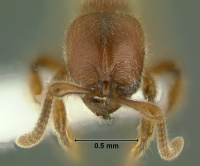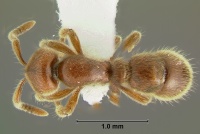Proceratium caledonicum
| Proceratium caledonicum | |
|---|---|

| |
| Scientific classification | |
| Kingdom: | Animalia |
| Phylum: | Arthropoda |
| Class: | Insecta |
| Order: | Hymenoptera |
| Family: | Formicidae |
| Subfamily: | Proceratiinae |
| Tribe: | Proceratiini |
| Genus: | Proceratium |
| Species: | P. caledonicum |
| Binomial name | |
| Proceratium caledonicum De Andrade, 2003 | |
One of the few specimens of this species was collected in rainforest.
Identification
A Proceratium species belonging to the silaceum clade, resembling Proceratium politum and Proceratium terraealtae. These three species share the body largely shining, but, in terraealtae the head is less shining than in caledonicum and politum. Proceratium caledonicum differs, in the worker, by the much narrower frontal carinae and from politum by the erect hairs longer and from terraealtae by the SI < 65 instead of > 70.
Keys including this Species
- Key to Oceanian Proceratium Species
- Key to Proceratium of the Pacific Oceanic Islands
- Key to Proceratium workers of the world
Distribution
Latitudinal Distribution Pattern
Latitudinal Range: -22.16666985° to -22.16666985°.
| North Temperate |
North Subtropical |
Tropical | South Subtropical |
South Temperate |
- Source: AntMaps
Distribution based on Regional Taxon Lists
Australasian Region: New Caledonia (type locality).
Distribution based on AntMaps
Distribution based on AntWeb specimens
Check data from AntWeb
Countries Occupied
| Number of countries occupied by this species based on AntWiki Regional Taxon Lists. In general, fewer countries occupied indicates a narrower range, while more countries indicates a more widespread species. |

|
Estimated Abundance
| Relative abundance based on number of AntMaps records per species (this species within the purple bar). Fewer records (to the left) indicates a less abundant/encountered species while more records (to the right) indicates more abundant/encountered species. |

|
Biology
Castes
Worker
Images from AntWeb
   
| |
| Holotype of Proceratium caledonicum. Worker. Specimen code casent0172099. Photographer April Nobile, uploaded by California Academy of Sciences. | Owned by ANIC, Canberra, Australia. |
Nomenclature
The following information is derived from Barry Bolton's Online Catalogue of the Ants of the World.
- caledonicum. Proceratium caledonicum De Andrade, in Baroni Urbani & De Andrade, 2003b: 327, fig. 132 (w.) NEW CALEDONIA.
- Type-material: holotype worker.
- Type-locality: New Caledonia: Mt Koghis, nr Noumea, 500 m., 26.vii.1978, Berlesate rainforest litter (S. & J. Peck).
- Type-depository: ANIC.
- Status as species: Liu, C., Fischer & Economo, 2015: 39 (in key).
- Distribution: New Caledonia.
Description
Worker
Head slightly longer than broad and with posteriorly diverging sides. Vertex in full face view convex. Glypeus reduced and as long as the antennal socltets. Anterior border of the clypeus truncate. Frontal carinae very narrow, about 1/4 of the head width, not covering the antennal insertions. Lateral expansions of the frontal carinae narrow, little raised, diverging on the two anterior fourths, converging on the third fourth, diverging and carinate only on the posterior fourth. Frontal area concave on the third fourth and with a marked, short longitudinal carina prolonging posteriorly. Head anterolaterally with a short, longitudinal carina. Genal carinae marked, each carina corresponding to the external border of a deep sulcus. Eyes visible as a dark dot below the integument, small and on the middle of the head sides. First funicular joint slightly broader than long. Funicular joints 2-10 broader than long. Last funicular joint as long as the sum of joints 6-10. Scapes short of the vertexal margin and gently thickening apically. Masticatory margin of the mandibles with 6-8 irregular denticles before the pointed apical tooth. Palp formula 2,2.
Mesosoma weakly convex in profile, shorter than maximum head length (mandibles included). Pronotal and propodeal sutures absent. Basal face of the propodeum declivous posteriorly. Area between the basal and declivous faces of the propodeum weakly concave and angulate on each side. Declivous face of the propodeum sloping posteriorly. Sides of the declivous face of the propodeum superficially marginate. Propodeal spiracle round and above mid height in lateral view.
Petiole subrectangular and not very thick. Anterior border of the petiole straight and anterolaterally carinate. Ventral process of the petiole large, lamellaceous anteriorly rectangular and posterior pointed. Postpetiole less than 1/3 shorter than gastral tergite I. Postpetiole in dorsal view with the anterior half diverging and the posterior half gently convex. Postpetiolar sternite anteromedially with a marked subtriangular projection, gently convex in side view. Constriction bctween postpetiole and gaster impressed. Gastral tergite I convex on the curvature. Remaining gastral tergites and sternites curved ventrally.
Legs not very elongate. All tibiae with a pectinate spur. Spurs of fore legs without basal spine. Fore basitarsi longer than the mid ones. Hind basitarsi about 1/4 shorter than hind tibiae. Second tarsomese of hind legs shorter than pretarsus. Pretarsal claws simple. Arolia absent.
Sculpture. Body largely shining and covered by minute piligerous punctures, the pLlrlctures denser, resembling minute reticulation with irregular rugosities on the anterolaleral third of the head. Legs minutely punctate. Body covered by hairs of three main types: (1) short, dense, suberect or subdecumbent on the whole body, sparse on the funicular joints; (2) longer than type (1), erect, relatively dense on the whole body, absent on the antennae; (3) shorter than hair type (1), dense and decumbent on the funicular joints only. In addition the funicular joints bear whitish, thick, appressed, sparse hairs, and the scapes with sparse hairs similar to type (2) but shorter.
Colour. Yellow-light brown.
Measurements in mm and Indices: TL 2.94; HL 0.67; HW 0.63; EL 0.03; SL 0.43; WL 0.81; PeL 0.22; PeW 0.28; HFeL 0.49; HTiL 0.39; HBaL 0.27; LS4 0.35; LT4 0.67; CI 94.0; SI 64.2; IGR 0.52.
Type Material
- Holotype, worker, Mt. Koghis near Noumea, 500m, New Caledonia, 25-vii-1978, Peck,J. & Peck,S., ANIC32-017663, Australian National Insect Collection; Berlesate rainforest litter.
Unless otherwise noted the text for the remainder of this section is reported from the publication that includes the original description.
Etymology
"Caledonicunz" is a neologism indicating the provenance of the species from New Caledonia.
References
- Baroni Urbani, C., de Andrade, M.L. 2003. The ant genus Proceratium in the extant and fossil record (Hymenoptera: Formicidae). Museo Regionale di Scienze Naturali, Monografie, 36, 1–492. (page 327, fig. 132 described)
References based on Global Ant Biodiversity Informatics
- Baroni Urbani C., and M.L de Andrade. 2003. The ant genus Proceratium in the extant and fossil record (Hymenoptera: Formicidae). Museo Regionale di Scienze Naturali, Monografie 36: 1-480.
- CSIRO Collection
- Jennings J. T., L. Krogmann, and C. Burwell. 2013. Review of the hymenopteran fauna of New Caledonia with a checklist of species. Zootaxa 3736(1): 1-53.


